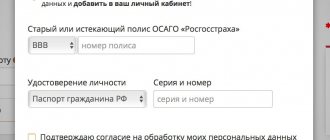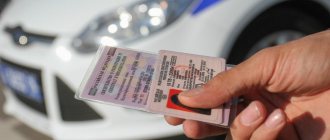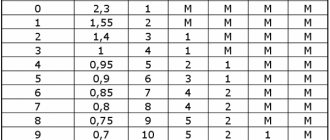Common Mistakes
Most often, errors occur when filling out the following data:
- Full name of the owner, policyholder and drivers
- Passport details of the policyholder
- Car brands
- VIN and license plate number of the vehicle
- Insurance company details
- Driver's license numbers and series
- Used in calculating coefficients
All information specified in the policy is verified by RSA. If the driver and car are already in the database, then it sends a notification to the insurer and demands correction. If insurance is taken out for the first time, then the information is recorded in the database, as usual, after which errors can only be detected when an insured event occurs. Data in the PCA always takes precedence over those specified in the policy.
In addition, the following may be considered an error:
- Filling the policy with paste of different colors or shades
- Differences in the handwriting used to fill out the policy
- Differences between the signatures and those indicated in the passports of the policyholder and the insurance company employee
- The presence of outdated or incorrect details in the policy
The difference between a paper and electronic OSAGO policy
When registering and issuing an MTPL policy, many procedures are carried out, during which an error may occur when entering information.
Considering the automation of many processes, a mistake made will most likely end up in the MTPL policy; therefore, the information in it will differ from the actual data.
Often, the discovered error appears in the MTPL agreement, on the basis of which a contract is concluded between the car owner and the insurance company. Below is information about the types of possible errors and the necessary actions from the driver that must be taken to eliminate them.
An insurance policy is not just a document confirming that the driver has a valid compulsory car insurance agreement. It contains detailed information about the driver and vehicle:
- number and validity period of the MTPL policy;
- personal data of the owner;
- technical data of the car;
- name of the insurance company;
- information about drivers allowed to drive the vehicle.
Any of the listed data contains important information; their incorrectness is unacceptable and can lead to undesirable consequences of a material and legal nature.
Depending on the format of the purchased MTPL policy, incorrect data entered may appear in different ways:
- Electronic policy. When concluding a contract under compulsory motor liability insurance remotely, the client receives an electronic version of the document, which is subsequently printed. In this case, the error occurs due to the client's fault, because When filling out information online, the original documents are not presented and the insurance company manager is unable to verify their relevance and compliance with valid data. Ultimately, incorrectly completed data ends up in the RSO and the unified traffic police database.
- Paper policy. Issued upon concluding an insurance contract at the company's office. Before issuing an MTPL policy, the manager checks the accuracy of the information entered by the client, which greatly reduces the likelihood of an error. But if it happens anyway, the insurance company is also responsible.
From the considered options for the occurrence of an error, we can conclude that a higher probability of inaccuracies occurs when issuing an electronic MTPL policy.
Before considering possible nuances for errors in the insurance policy, you need to understand what options for incorrect information may be:
- typo in the personal data of the driver or owner of the vehicle;
- date of conclusion or expiration of the contract;
- Incorrect information about the model or characteristics of the vehicle.
Other information does not pose any serious problems, since it is not required for insurance or other activities.
Depending on the type of typo, it can become a big problem for the driver:
- Incorrectly filled in data of the owner or persons authorized to drive transport is equivalent to the absence of a compulsory motor liability insurance policy. In this case, the road patrol is guided by Article 12.37 of the Code of Administrative Offenses (lack of compulsory motor liability insurance policy) and may issue an administrative fine in the amount of 500 rubles.
- Incorrect vehicle information. In this case, problems may arise if the car is damaged. The insurance company can freely refuse compensation, citing the discrepancy between the data of the damaged vehicle and the characteristics specified in the MTPL policy.
In the latter case, sometimes there is a deliberate discrepancy between the information in the insurance policy and the actual data.
An unscrupulous client, when applying for an electronic MTPL policy, in order to reduce tariffs, may knowingly indicate lower characteristics of the car (for example, engine power up to 249 hp.
with actual more than 250 hp). If the client's intent is proven, the insurance company has the right to terminate the contract.
It was noted above that the electronic MTPL policy, unlike its paper counterpart, is purchased at the client’s request. The data is filled in without providing original documents. Therefore, the driver is responsible for any discrepancies and must take action if an error is discovered.
To do this, you need to contact the company with a free-form application. It must indicate the reason for the application, valid information and a list of attached documents:
- MTPL insurance policy (when contacting the company’s office with an electronic policy, you need to print it out);
- insurance contract between the client and the company;
- identification document of the applicant;
- a document confirming the current information for replacement.
After reviewing the application, the insurer will make changes to the MTPL policy, indicating current information. They are entered as follows:
- in the electronic policy and unified database, information is updated by a company specialist;
- in the paper version, the current values are indicated next to the erroneous data, and special marks indicate replacement.
The policy cannot be replaced with a new original or duplicate. The insurance contract also remains valid. The entire procedure takes no more than two days. Upon completion of the replacement of information, the client can receive an MTPL policy at the company’s office, or by email, depending on the version of the document.
It often happens that a driver, hoping that the insurer is serious, receives a policy and does not check it. And the error in the information is discovered after the accident. In this situation, the insurance company is highly likely to refuse payment. The reason often cited is the discrepancy between the data in the documents and the MTPL policy.
Responsibility for the accuracy of the data in the electronic policy lies entirely with the driver. Proving unintentional provision of information is possible only through court. Because The situation is complex and initially not in favor of the driver; to file a claim, it is recommended to seek the services of auto lawyers. They will speed up the process and help you quickly receive compensation under compulsory motor liability insurance.
Summing up
The MTPL policy should be carefully reviewed immediately after receipt. And if incorrect information is discovered, immediately take measures to correct it.
When checking at a stationary checkpoint, you can earn a fine, and in the event of a transport accident you may be left without compensation at all.
The procedure for replacing data in an MTPL policy is not complicated and requires little time, so do not neglect the possibility of replacing data if incorrect information is discovered.
- name of the insurance company;
- personal data of the driver to whom the MTPL policy is assigned;
- information about incorrect information and data for correcting it;
- list of documents attached to the application;
- date and signature of the applicant.
In the application itself, it is necessary to explain that there is an error in the compulsory motor liability insurance policy, how to correct it, and what data to replace the incorrect information with. The application is submitted to the nearest department of the company where the MTPL policy is issued, or send an online application.
Along with the application, you will need to submit an identification document, a driver’s license of the driver under the contract and a document that establishes the incorrectness of the data in the compulsory motor liability insurance policy.
The long-term practice of using MTPL insurance policies includes many different errors that render the document unusable. If you do not want to spend some time at the traffic police department to clarify the circumstances of the non-compliance of the compulsory motor insurance document with the requirements, we recommend that you familiarize yourself with the list of the most common errors in advance.
More and more citizens prefer to apply for insurance online without visiting the office of the insurance company. The insurance itself will be provided electronically.
It's quite simple to use. Some drivers print out the document, while others download the policy to their phone.
Despite the imperfections of electronic databases, this method of obtaining MTPL insurance is very popular.
The grounds for adjusting data in the electronic policy may be:
- adding new drivers;
- changes in driver's license data due to document replacement;
- obtaining a new passport;
- change of registration;
- inaccuracies made accidentally or deliberately.
If you are the culprit of an accident, the coefficient, on the contrary, increases, its maximum value is 2.45. How much it will increase depends on both your current coefficient and the number of accidents (payments) due to your fault during the year.
What's the problem? Until January 1, 2013, everything was more or less simple: when applying for a new policy, agents asked if there were any accidents during the year that were your fault - and if not, they were guided by the data from the previous policy, making another 5% discount from the base rate.
At an insurance agency, when purchasing a compulsory motor liability insurance policy, the insurer “enters” the data on your car into the database.
All entered information is reliable (the agent is personally responsible for this) and is stored in a single AIS RSA database. Today you can buy a policy online.
In this case, the driver enters all the required information himself, and the system checks with the database (the insurance agent entered it when you purchased your last insurance policy).
Starting from July 1, 2015, Russia introduced the possibility of purchasing an MTPL insurance policy by a driver online, i.e.
through the Internet. Currently, several insurance companies provide a similar service.
This article will talk about how to buy a policy online, as well as the difficulties that a driver may encounter. In addition, the design of an electronic MTPL policy will be considered using the example of the Rosgosstrakh company.
Legislation in the field of compulsory motor liability insurance, including regarding the rules for issuing a policy, changes quite often - for example, from July 1, car owners received the right to renew policies electronically via the Internet (clause
7.2 art. 15 Federal Law of April 25, 2002
No. 40-FZ “On compulsory insurance of civil liability of vehicle owners”; hereinafter referred to as the law on compulsory motor liability insurance). However, with the start of issuing electronic policies, questions regarding the procedure for concluding and amending an MTPL agreement have not decreased.
It doesn’t matter what kind of insurance we buy – DAMAGE, CASCO, MTPL or extended MTPL – in all cases we pay for our peace of mind.
We pay for our confidence that if, God forbid, something happens... And at the same time, everyone at least for a moment had the thought: “Aren’t they being deceived?” Who will insure against fraud at the stage of purchasing MTPL or CASCO insurance?
Nobody! Only your attention and knowledge can help you avoid deception.
Sooner or later, every car owner finds himself in a situation where a car is stopped to check documents and be searched with varying degrees of bias, both those who are behind the wheel and those who have entrusted it to a “sober driver.”
Reasons for appearance
Errors in the MTPL policy can occur for three reasons:
- Negligence of the insurer or policyholder. Errors may occur when filling out a policy or transferring data to RSA
- The specified data is out of date. An error is considered to be out-of-date information in the policy - for example, when replacing a passport or driver’s license
- The intent of one of the parties. The policyholder may intentionally provide false information in order to reduce the cost of the policy, or draw up a document for a dummy person. Intentional errors may also occur on the part of the insurer - for example, he may intentionally transmit incorrect data to the RSA when applying for a policy via the Internet
Where and how to fix the error
How to correct an error in the MTPL policy? Under no circumstances should you make changes to the document yourself. The form must be completed only by the insurer.
Corrections are made in several ways:
- On a valid contract, the incorrect word or letter is carefully crossed out, and the correct information is indicated in the nearest free space: above or to the right of the error. In the “Special Notes” field, the phrase “Believe the Corrected” is written, signed and sealed.
- The old policy is crossed out, destroyed or remains with the policyholder, and a new one is issued in return free of charge. It indicates in the same “Special Notes” field that this is a revision of the form, and also states the reason for the re-issuance.
What problems may arise due to errors in the policy?
If the policy contains errors, it may be invalidated at any time. This can lead to various consequences, both minor and severe:
- A traffic police officer may issue a fine for the absence of a policy if he discovers a discrepancy in information in the document or in the RSA
- If an accident occurs and the driver is found guilty, the insurance company may demand compensation for the amount of damage paid from the driver in court. Or she will refuse to compensate for damage under a policy with errors at all
- In extreme cases, the insurance policy may be considered fraudulent, and you may be accused of attempted fraud. You will have to prove that you did not intentionally provide false information
What problems will an error in OSAGO cause?
If an insured event occurs, the driver has the right to demand payment, even if there is an error or typo in the policy. But before that you will have to make changes to the document. Considering that after the accident there will be many other matters and bureaucratic problems, it is better to take care in advance to correct all inaccuracies in the policy.
An error during registration is not a reason to refuse payments! There is also no fine for a typo in compulsory motor insurance when checking documents by traffic police officers.
If, when registering e-OSAGO, there are inaccuracies in driving experience, engine power, registration address, or other errors that reduce the cost of insurance, the car owner may be sued for fraud.
It will be difficult to prove that he did this intentionally, for selfish purposes. But no one needs unnecessary court proceedings, wasting nerves and time, so it is better to correct the typo immediately after discovery, even if you have to pay extra.
What to do if detected
If you discover errors after taking out your policy, you should contact the insurance company as soon as possible. You cannot make changes to the policy yourself, otherwise the document will be declared invalid. Report the problem to your insurance company and fill out a correction form.
To correct, you will need the original policy, the policyholder's passport and documents confirming the correct data. For example, if the VIN of a car was incorrectly specified, then you will need its PTS and STS. When entering new data, carefully check the policy for errors before collecting it. Amendments are made to the current policy, or a new form is filled out with current information.
The insurer will send the new information to the RSA itself—there is no need to apply there separately. At the same time, you should be careful when changing the number and series of your driver's license - if you change them, you risk losing the accrued KBM. To save it, additionally fill out an application for maintaining the coefficient with the insurance company.
How to correct an error in an electronic OSAGO policy
It is believed that the electronic database will not allow registering a document with incorrectly filled in fields. In practice, there are often cases when the policyholder makes a mistake, the program does not recognize the error and issues an MTPL with incorrect information. Not all insurance companies provide verification of entered data using the PCA database.
It is easier to correct an error in an electronic policy than in a paper one. Usually, all you need to do is log into your personal account on the insurer’s website, select the desired policy and the editing option. Specify the information that needs to be corrected and enter the current information. Upload scanned copies of documents confirming the information. After checking and making corrections, the insurance company will send the corrected document by email.
How much does it cost to correct an OSAGO policy?
According to the law, making any changes to the MTPL policy is completely free. The insurance company does not have the right to charge any fees for correcting the document.
The only exception is if the cost of the policy changes after the changes are made. In this case, you will need to pay the insurer the difference between the cost of the policy before and after the amendments.
What to do if admitted?
Policyholders should know that RSA has developed a special methodological manual that sets out the rules governing the introduction of corrections of incorrect data in a car insurance contract.
According to clause 4.1 of this manual, the basis for making corrections to the policy form is the presence in this form of typos and errors that were made during the preparation of this document. Insurance organizations consider errors in the contract form to be the discrepancy between the information contained in the documents and the information included in the policy form.
In addition, an incorrectly calculated insurance premium, which was paid by the policyholder for the execution of this contract, is considered an error. What should a car insurer do if typos or inaccurate data were found in his contract form?
The methodological manual contains paragraph 4.2, which contains an algorithm according to which insurers can make amendments to the contract concluded with an insurance company client.
According to this paragraph, the insurer must cross out the data entered incorrectly into the OSAGO form and write down the correct data either next to it or on top. Next, in the “Special Notes” field, the insurance agent must enter the entry “Corrected Believe” , after which the date of the changes is entered, the employee’s personal signature and the organization’s seal are affixed.
Corrections are made to the policy in which errors were made and in the “Special notes” field of the new policy form, which is issued to the policyholder. Purely theoretically, unreliable data cannot be found in insurance policies issued online, since the system will not allow such a policy to be issued. But in practice, there are still electronic contracts with erroneous data.
In this case, the policyholder should contact the office of his insurance company. The client at the insurance company office will have to write a corresponding application for making corrections to the electronic policy.
IMPORTANT : If the insurance company for any reason refuses to correct the client’s e-OSAG, then it is obliged to provide him with a written refusal.
It happens that the electronic document contains only a minor error, for example, a letter is missing in the client’s last name. In this case, you should go to the IC website and go to the “Make changes” tab. In the window that opens, you must enter the correct information. After the system has verified your data, you will receive a new policy form by email. The client does not need to pay extra for this service . You can find more information on how to make changes to your MTPL policy in the office or online in this article.
Question answer
When do amendments to the policy take effect?
Amendments to the policy become valid on the day the amendments are made. New information is entered into the RSA within three to five days.
What to do if the insurance company does not accept an application to change data?
If the insurer does not want to correct errors in the policy, then you will have to go to court. Attach documents confirming the real data of the policyholder and drivers to the evidence.
Can I count on an insurance payment if there are typos in the policy?
The presence of typos in a document is not grounds for denial of the policy. At the same time, it is important that all information is indicated correctly in the traffic police report. The policy still needs to be corrected - this can be done at the time the insurance claim is made.
The procedure for making changes to the OSAGO policy
The procedure for correcting inaccurate data and errors requires the car owner to perform certain actions. In particular, we are talking about the following steps:
- After identifying an error, you must prepare all the required documents. Here you will need a policy with an error and a power of attorney to make changes to the MTPL policy if it is not the owner of the car who applies to the insurance company.
- When visiting the policyholder, you will need to draw up an application to correct an error in the compulsory motor liability insurance policy according to the current sample. A company representative can help with this.
- After checking the application, corrections will be made to the policy and the citizen will receive a new document or an old form, but with correctly completed corrections.
applications to correct an error in the MTPL policy
Usually, all actions are performed immediately upon application and do not require a long wait from the car owner.
Where to contact?
This point is very important, since you only need to seek help from the insurance company with which the insurance agreement was signed . If the driver’s demands are justified, and the company refuses to make changes, the citizen has the right to appeal to the court.
Timing and cost of making changes
By law, all changes to the policy must be made on the day of application. In the future, new information enters the RSA data bank no later than five days from this moment. As for the cost, all corrections are made free of charge.
Sources
- vedomosti.ru: An error in filling out an MTPL policy can cost drivers dearly
- avtoguru.pro: What to do if there is an error in the MTPL policy, and how to correct it?
Recommended for you
- How is the loss of marketable value of a car considered under compulsory motor liability insurance?
- Is compulsory motor insurance necessary when moving a car?
- OSAGO: New life for an old fraudulent scheme
Victor Avdeev Head of SEO department #VZO. He has been working in the project since 2018, before that he was freelancing. Manages the work of marketers and SEO specialists. Experience working on similar projects allows him to effectively participate in the development of our service.
(12 ratings, average: 4.6 out of 5)











